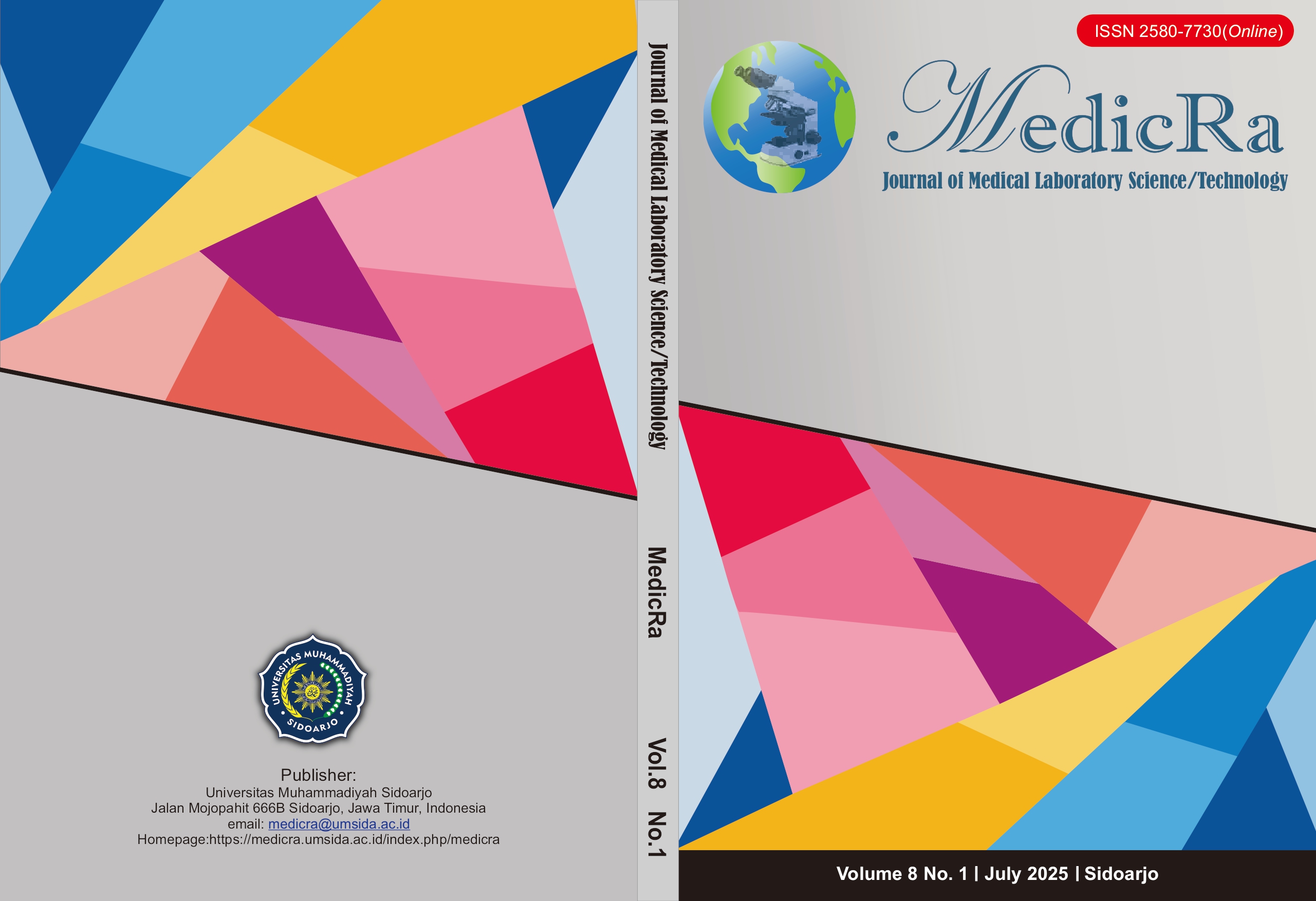Proliferation, Migration, and Expression of Tumor Necrosis Factor-α from Green Tea Leaf Extract (Camellia sinensis) on Keloid Fibroblast Cells
Proliferasi, Migrasi, dan Ekspresi Tumor Necrosis Factor-α Ekstrak Daun Teh Hijau (Camellia sinensis) pada Sel Fibroblas Keloid
DOI:
https://doi.org/10.21070/medicra.v8i1.1769Keywords:
Green Tea Leaf Extract, Keloid, Migration, Proliferation, TNF-αAbstract
Keloid is a fibroproliferative dermal disorder caused by abnormal wound healing, characterized by excessive collagen deposition that extends beyond the wound boundaries. Keloids can cause pruritus and even pain. In addition to these two issues, keloids also diminish a person's quality of life due to aesthetic problems, especially if they appear on the face or other visible areas of the skin. Combination treatments for keloids are usually more successful than single treatments. Green tea leaf extract contains epigallocatechin-3-gallate polyphenols as anti-inflammatory agents. The aim of this study is to determine the potential of green tea leaf extract by observing the proliferation, migration, and expression of TNF-α in keloid fibroblast cells. Keloid fibroblast cells were divided into five treatment groups (TH100, TH200, TH400, TH800, and DEX100) and one negative control (DS). Cell proliferation was tested using a cell counting kit-8, migration was assessed using a scratch assay, and TNF-α expression was measured using an ELISA kit. All data were analyzed using SPSS, performing One-Way ANOVA, followed by Kruskal Wallis and Mann Whitney tests. The results showed that green tea leaf extract at a dose of 800 μg/mL significantly reduced the proliferation and migration rate of keloid fibroblast cells (p < 0.05). Meanwhile, in the TNF-α expression test, no significant difference was found in reducing TNF-α expression levels in keloid fibroblast cells (p > 0.05). Green tea leaf extract has the potential to be used as an alternative treatment for keloids as it reduces the proliferation and migration of keloid fibroblast cells.References
Choirunanda, A.F., Praharsini I. (2019). Profil Gangguan Kualitas Hidup Akibat Keloid pada Mahasiswa Fakultas Kedokteran Universitas Udayana Angkatan 2012 – 2014. J Med UDAYANA, 8(8), 1-5. Retrieved from https://ojs.unud.ac.id/index.php/eum/article/download/52205/30891
Dachlan I, Soebono H, Aryandono T. (2015). Pengembangan 5α-Oleandrin Isolasi dari Daun Kembang Mentega (Nerium Indicum Mill.) Sebagai Obat Anti Keloid Kajian in Vitro pada Sel Fibroblas Keloid. Disertasi. Universitas Gajah Mada Yogyakarta
Khan, N., Afaq, F., Saleem, M., Ahmad, N., Mukhtar, H. (2006). Targeting Multiple Signaling Pathways by Green Tea Polyphenol (?)-Epigallocatechin-3-Gallate. Cancer Res, 66(5), 2500-2505. doi:10.1158/0008-5472.CAN-05-3636
Kurnia, P.A., Ardhiyanto, H.B., Suhartini. (2015). Potensi Ekstrak Teh Hijau ( Camellia sinensis ) Terhadap Peningkatan Jumlah Sel Fibroblas Soket Pasca Pencabutan Gigi pada Tikus Wistar ( The Potency of Green Tea Extract [ Camellia sinensis ] Against Increase of Fibroblast Cells on Socket Post Tooth Extr. e-Jurnal Pustaka Kesehat, 3(1), 122-127. Retrieved from https://jpk.jurnal.unej.ac.id/index.php/JPK/article/view/2458
Kusmiyati, M., Sudaryat, Y., Lutfiah, I.A., Rustamsyah, A. (2015). Aktivitas antioksidan , kadar fenol total , dan flavonoid total dalam teh hijau ( Camellia sinensis ( L .) O . Kuntze ) asal tiga perkebunan Jawa Barat. J Penelit Teh dan Kina, 18(2), 101-106. Retrieved from https://tcrjournal.com/index.php/tcrj/article/download/71/52
Mbuthia, K.S., Mireji, P.O., Ngure, R.M. (2017). Tea ( Camellia sinensis ) infusions ameliorate cancer in 4TI metastatic breast cancer model. BMC Complement Altern Med, 17(202), 1-13. doi:10.1186/s12906-017-1683-6
Nugrahini, S. (2018). Peningkatan Aktivitas Sel Epitel pada Kasus Denture Stomatitis Oleh Gel Epigallocatechin Gallate 0,5%. IJKG, 14(2), 45-50. Retrieved from https://doi.org/10.46862/interdental.v14i2.375.
Pavel, M., Renna, M., Park, S.J., Menzies, F.M., Ricketts, T., Füllgrabe, J., Ashkenazi, A., Frake, R.A., Lombarte, A.C., Bento, C.F., Franze, K., Rubinsztein, D.C. (2018). Contact inhibition controls cell survival and proliferation via YAP/TAZ-autophagy axis. Nat Commun, 9(2961), 1-18. doi:10.1038/s41467-018-05388-x
Ramadhani, Y., Rahmasari, R.R.P., Prajnasari, K.N., Alhakim, M.M., Aljunaid, M., Al-Sharani, H.M., Tantiana, Juliastuti, W.S., Ridwan, R.D., Diyatri, I. (2022). A mucoadhesive gingival patch with Epigallocatechin-3-gallate green tea (Camellia sinensis) as an alternative adjunct therapy for periodontal disease: A narrative review. Dent J, 55(2), 114-119. doi:10.20473/j.djmkg.v55.i2.p114-119
Restuti, R.D. (2014). Pengaruh deksametason terhadap proliferasi sel , kadar IL-α , dan TNF-α pada biakan kolesteatoma. ORLI, 44(1), 11-18. Retrieved from https://orli.or.id/index.php/orli/article/view/78
Sinto, L. (2018). Scar Hipertrofik dan Keloid : Patofisiologi dan Penatalaksanaan. CDK-260, 45(1), 29-32. Retrieved from https://media.neliti.com/media/publications/397730-scar-hipertrofik-dan-keloid-patofisiolog-cc6396e1.pdf
Supit, I.A., Marunduh, Pangemanan, D.H.C., Marunduh, S.R. (2015). Profil Tumor Necrosis Factor ( TNF- α ) Berdasarkan Indeks Massa Tubuh ( IMT ) pada Mahasiswa Fakultas Kedokteran UNSRAT angkatan 2014. J e-Biomedik. 3(2):640-643. Doi: 10.35790/ebm.v3i2.8621
Tabaga, K.D., Durry, M.F., Kairupan, C. (2015).Efek Seduhan Teh Hijau (Camellia sinensis) Terhadap Gambaran Histopatologi Payudara Mencit yang Diinduksi Benzo (α) Pyrene. J e-Biomedik, 3(2), 544-548. Doi: 10.35790/ebm.v3i2.8138
Tsai, C.H., Ogawa R. (2019). Keloid research : current status and future directions. Scars, Burn Heal, 5(2019), 1-8. doi:10.1177/2059513119868659
Waruwu, L.N., Bintang, M., Priosoeryanto, B.P. (2019). Ekstrak dan Fraksi N-heksana Teh Hijau sebagai Antiproliferasi Sel Kanker Payudara MCM-B2 In Vitro ( N-hexane Extract and Fraction of Green Tea as Antiproliferation of MCM-B2 Breast Cancer Cells In Vitro ). Curr Biochem, 6(2), 92-105. Retrieved from https://repository.ipb.ac.id/handle/123456789/95513
Zhu, Y.Q., Zhou, N.H., Xu, Y.W., Liu, k., Li, W., Shi, L.Y., Hu, Y.X., Xie, Y.F., Lan, J., Yu, Z.Y. (2022). Genome-wide analysis of Chinese keloid patients identifies novel causative genes. Ann Transl Med, 4(16), 883 doi:10.21037/atm-22-1303
Downloads
Additional Files
Published
How to Cite
License
Copyright (c) 2025 Lia Sari Utami Dewi

This work is licensed under a Creative Commons Attribution 4.0 International License.






